The Future of Agriculture Exploring the Possibilities of Indoor Farming
The future
of agriculture is changing dramatically as the world's population expands and
the need for food rises. Innovative solutions are needed to maintain a
sustainable food supply because traditional farming techniques are no longer
adequate to meet these needs. Indoor farming is one such idea that is quickly
gaining popularity as a potential alternative to traditional agriculture.
Lessening
the effects of the weather outside, providing a year-round continual supply of
fresh veggies from indoor farming. However, the rising demand for healthy,
fresh meals with good nutritional value boosts the market expansion. In
addition, according to a research report by Astute Analytica, the Global Indoor Farming Market growing at a compound annual growth rate (CAGR) of 10.1% over
the projection period from 2023 to 2031.
How will indoor farming alter the future of agriculture?
Indoor
farming can offer local products from nearby buildings rather than cultivating
them on large farms and then shipping them over extensive distances in
airplanes and trucks. This means food will be fresher and consume less fuel.
Additionally, it frequently yields more than traditional farms do.
Why hasn't indoor farming been a global remedy?
Cost is a
significant barrier to indoor farming. The rain and sun are free. Complex
growing systems, or LED lighting aren’t. While certain structures use
electricity from wind turbines, fossil fuel-powered vertical farms might make
the problem of climate change worse rather than better.
Food
varieties that can be cultivated indoors
Although
grains like wheat and barley are still grown outdoors in vast fields because
they need so much space, many herbs (such as coriander, basil, mint, and dill),
leafy greens (such as spinach, kale, and lettuce), and young plants (such as
strawberry, tomato, and potato) have shown to be especially suited to indoor
farming.
The positive aspects of indoor farming
Managing
supply chain: People
can gain more control over their supply chain and lessen the impact of shipping
expenses by incorporating indoor farming into their current operations for
propagation. Growing their own seedlings and starter plants also shields their
business from supply chain problems brought on by climatic calamities like
hurricanes or droughts.
Enhance
uniformity of starter plants: An indoor farm may exist next to a field or glasshouse as a
source for a wholesome and dependable supply of young plants. These farms grow young plants, including seed
potatoes, tree seedlings, strawberries, broccoli, and tomatoes.
Enhance yields and reduce waste: Some people have disclosed that a sizable portion of their imported young plants are contaminated in some way. They can save losses by up to 30% by raising their young plants on a farm.

Comments
Post a Comment